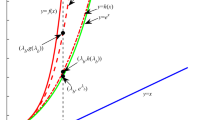Abstract
In this paper, aiming at the drawback of the popular dimensionality reduction method Discriminant Sparse Neighborhood Preserving Embedding(DSNPE), i.e. the construction of its between-class scatter is too complexity, a novel algorithm Discriminant Locality Preserving Projection (DSLPP) is proposed. Our proposal retains the local sparse reconstructive relationships of DSNPE and constructs a novel between-class scatter by using all mean faces as sparse representation dictionary. In particular, DSLPP preserves the sparse reconstructive relationship of mean face, so then it can not only efficiently reduce the between-class scatter computation complexity of DSNPE, but also increase the discriminant power. In the experiment, we compare DSLPP with classic and state-of-the-art dimensionality reduction methods on the publicly available data sets such as ORL, Yale, UMIST, and AR, and further apply the Gabor feature into DSLPP on AR face database to further improve its performance. The experimental results show that DSLPP is able to obtain a better representation of the class information and achieve much higher recognition accuracy.








Similar content being viewed by others
References
Belhumeur PN, Hespanha JP, Kriengman DJ (1997) Eigenfaces vs. Fisherfaces: Recognition using class specific linear projection. IEEE Trans Pattern Anal Mach Intell 19(7):711–720
Belkin M, Niyogi P (2003) Laplacian eigenmaps for dimensionality reduction and data representation. Neural Comput 15(6):1373–1396
Chen HT, Chang HW, Liu TL (2005) Local discriminant embedding and its variants. In: Proceedings of the IEEE computer visual and pattern recognition (CVPR), pp 846– 853
Cheng B, Yang J, Yan S, Fu Y, Huang T (2010) Learning with L1-graph for image analysis. IEEE Trans Image Process 19(4):858–866
Chun D, Shi-Lin Z, Ji-Xiang S, Hao S, Liang-Liang W (2013) Discriminant embedding by sparse representation and nonparametric discriminant analysis for face recognition. J Cent South Univ 20:3564–3572
Cox TF, Cox MAA (2000) Multidimensional Scaling, 2nd edn. Chapman and hall/CRC
Graham DB, Allinson NM (1998) Characterizing virtual eigensignatures for general purpose face recognition. In: Face recognition: From theory to applications, vol 163, pp 446– 456
Gui J, Sun Z, Jia W, Hu R, Lei Y, Ji S (2012) Discriminant Sparse Neighborhood Preserving Embedding for Face Recognition. Pattern Recogn 45 (8):2884–2893
He X, Niyogi P (2003) Locality preserving projections. In: Proceedings of Conference on Advances in Neural Information Processing Systems (NIPS)
He X, Cai D, Yan S, Zhang H (2005) Neighborhood preserving embedding. In: Proceedings of the IEEE international conference on computer vision (ICCV), pp 1208–1213
He X, Yan S, Hu Y, Niyogi P, Zhang H-J (2005) Face recognition using Laplacianfaces. IEEE Trans Pattern Anal Mach Intell 27(3):328–340
Huang P, Tang Z, Chen C, Yang Z (2014) Local maximal margin discriminant embedding for face recognition. J Vis Commun Image R 25:296–305
Joia P, Paulovich F, Coimbra D, Cuminato J, Nonato L (2011) Local affine multidimensional projection. IEEE Trans Vis Comput Graph 17(12):2563–2571
Jolliffe IT (1986) Principal component analysis. Springer, New York
Kong J, Wang S, Wang J, Ma L, Fu B, Lu Y (2009) A novel approach for face recognition based on supervised locality preserving projection and maximum margin criterion. International Conference on Computer Engineering and Technology ICCET 2009(1):419–423
Lai Z, Li Y, Wan M, Jin Z (2013) Local sparse representation projections for face recognition. Neural Comput Applic 23:2231–2239
Li HF, Jiang T, Zhang KS (2006) Efficient and robust feature extraction by maximum margin criterion. IEEE Trans Neural Netw 17(1):157–165
Li W, Ruan Q, Wan J (2014) Dimensionality reduction using graph-embedded probability-based semi-supervised discriminant analysis. Neurocomputing 138:283–296
Lishan Q, Songcan C, Xiaoyang T (2010) Sparsity preserving projections with applications to face recognition. Pattern Recogn 43:331–341
Lu G-F, Jin Z, Zou J (2012) Face recognition using discriminant sparsity neighborhood preserving embedding. Knowl-Based Syst 31:119–127
Martinez AM, Benavente R (1998) The AR face database, CVC, Univ. Autonoma Barcelona, Barcelona, Spain, Technical Report, 24
Paulovich F, Nonato L, Minghim R, Levkowitz H (2008) Least square projection: a fast high-precision multidimensional projection technique and its application to document mapping. IEEE Trans Visual Comp Graph 14(3):564–575
Raudys SJ, Jain AK (1991) Small sample size effects in statistical pattern recognition: Recommendations for practitioners. IEEE Trans Pattern Anal Mach Intell 13(3):252–264
Roweis ST, Saul LK (2000) Nonlinear dimension reduction by locally linear embedding. Science 290(5500):2323–2326
See (http://www.cad.zju.edu.cn/home/dengcai/Data/FaceData.html)
Tenenbaum JB, da Silva V, Langford JC (2000) A global geometric framework for nonlinear dimensionality reduction. Science 290:2319–2323
Tibshirani R (1996) Regression shrinkage and selection via the lasso. J R Statist Soc Ser B (Methodological) 58(1):267–288
Weinberger KQ, Saul LK (2006) An introduction to nonlinear dimensionality reduction by maximum variance unfolding. In: Proceedings of the 21st National Conference on Artificial Intelligence, vol 2, pp 1683–1686
Wright J, Yang AY, Ganesh A, Sastry SS, Ma Y (2009) Robust face recognition via sparse representation. IEEE Trans Pattern Anal Mach Intell 31 (2):210–227
Wright J, Ma Y, Mairal J, Sapiro G, Huang T-S, Yan S (2010) Sparse representation for computer vision and pattern recognition. In: Proceedings of the IEEE, Special Issue on Applications of Compressive Sensing and Sparse Representation, vol 98, pp 1031–1044
Wright J, Ma Y, Mairal J, Sapiro G, Huang T, Yan S (2010) Sparse representation for computer vision and pattern recognition. Proc IEEE 98(6):1031–1044
Yan S, Xu D, Zhang B, Zhang H, Yang Q, Lin S (2007) Graph embedding and extensions: a general framework for dimensionality reduction. IEEE Trans Pattern Anal Mach Intell 29(1):40–51
Yan S, Wang H (2009) Semi-supervised learning by sparse representation. In: SIAM International Conference on Data Mining (SDM), pp 792–801
Yang-Qing J, Fei-Ping N, Chang-Shui Z (2009) Trace ratio problem revisited. IEEE Trans Neural Netw 20(4):729–735
Yang M, Zhang L (2010) Gabor feature based sparse representation for face recognition with gabor occlusion dictionary. Computer Vision-ECCV:448–461
Yang J, Chu D, Zhang L, Xu Y, Yang J (2013) Sparse representation classifier steered discriminative projection with applications to face recognition. IEEE Trans Neural Netw Learn Syst 24(7):1023–1035
Yang M, Zhang L, shiu S, Zhang D (2013) Gabor feature based robust representation and classification for face recognition with Gabor occlusion dictionary 46(7):1865–1878
Yang M, Zhang L, Feng X, Zhang D (2014) Sparse representation based fisher discrimination dictionary learning for image classification. Int J Comput Vis 109 (3):209–232
Yu W, Teng X, Liu C (2006) Face recognition using discriminant locality preserving projections. Image Vis Comput 24(3):239–248
Zhang Z, Zha H (2005) Principal manifolds and nonlinear dimensionality reduction via tangent space alignment. SIAM J Sci Comput 26(1):313–338
Zhao H, Sun S, Jing Z, Yang J (2006) Local structure based supervised feature extraction. Pattern Recogn 39:1546–1550
Zhao M-B, Zhang Z, Chow TW (2012) Trace ratio criterion based generalized discriminative learning for semi-supervised dimensionality reduction. Pattern Recogn 45:1482–1499
Zang F, Zhang J (2011) Discriminative learning by sparse representation for classification. Neurocomputing 74:2176–2183
Zhen-Yue Z, Jing W, Hong-Yuan Z (2012) Adaptive manifold learning. IEEE Trans Pattern Anal Mach Intell 34(2):253–265
Zhong F, Zhang J, Li D (2014) Discriminant locality preserving projections based on L1-norm maximization. IEEE Transactions on Neural Networks and Learning Systems 25(11):2065–2074
Zhu L, Zhu S (2007) Face recognition based on orthogonal discriminant locality preserving projections. Neurocomputing 70(7-9):1543–1546
Acknowledgments
This work was supported by the National Natural Science Foundation of China under Grant No. 61472297, U1404622 and 61503082.
Author information
Authors and Affiliations
Corresponding author
Rights and permissions
About this article
Cite this article
Yang, Y., Wang, Y. & Xue, X. Discriminant sparse locality preserving projection for face recognition. Multimed Tools Appl 76, 2697–2712 (2017). https://doi.org/10.1007/s11042-015-3212-2
Received:
Revised:
Accepted:
Published:
Issue Date:
DOI: https://doi.org/10.1007/s11042-015-3212-2




